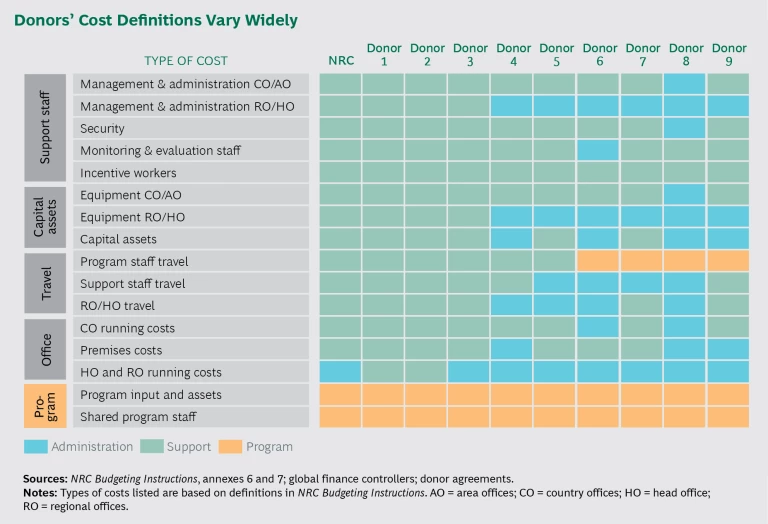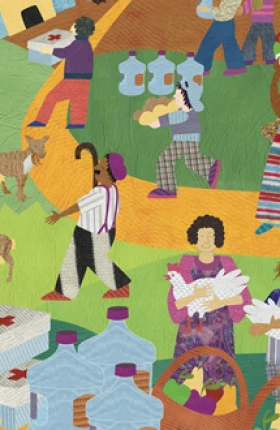Nongovernmental organizations (NGOs) and other humanitarian nonprofits face enormous risks, challenges, and constraints while tending to the needs of the world’s most vulnerable populations. They could not accomplish this important work without the commitment, financial support, and partnership of UN agencies, governments, and private foundations. Over the years, however, the administrative aspects of these partnerships have begun to draw substantial time and resources away from the people that the institutional donors are trying to help.
In 2016, the Norwegian Refugee Council (NRC) and The Boston Consulting Group conducted a study that sought to quantify the time the NRC spent on administrative activities. The study did not question the need for accountability and transparency in the use of donor funding, which all parties understand and respect. Institutional donors have many stakeholders—including governments, public interest groups, and taxpayers—that have a right to know how such groups use their funds.
We conducted a series of workshops with NRC staff members who interact with donors either in the field or through functions related to financial, legal, or donor relations. Although the study focused on the NRC, conversations with other NGOs and donors confirmed that the problems we identified are typical in the humanitarian sector and that the initiatives we propose could apply broadly across aid organizations. By starting a dialogue on how to reduce paperwork and other administrative aspects of donor partnerships, we hope ultimately to help NGOs direct more resources to the end beneficiaries—and thus to increase their impact.
Reporting Requirements Are Crucial but Problematic
NGOs and institutional donors and partners enter into grant agreements and contracts that have a range of specifications, including suitable projects for funding, appropriate implementation of projects, frequency and detail of follow-up reporting, formatting and delivery of reports, and distinctions between covered and noncovered costs. Private donors have their own sets of requirements.
Much of the paperwork related to these agreements and contracts stems from reporting requirements that institutional donors must satisfy for tax purposes, to provide a full accounting to their governments of the disposition of awarded or allocated funds, and to meet increasing demands for transparency. Although these institutional checks and balances help ensure that donated funds reach their designated targets and achieve their desired impact, our research revealed three problems that increase the administrative load on NGOs.
Varied Document Formats and Cost Definitions Among Donors
The required formats for financial reporting vary widely among donors, leading to the first set of administrative inefficiencies.
Problem. Estimating conservatively, if the NRC’s nine largest donors consistently used the same format, the organization would save approximately 11,000 hours per year on financial reporting alone. Multiplied by the 27 largest NGOs in the NRC’s peer group, the amount of time saved would be 297,000 hours per year.
Similarly, a comparison of the documentation requirements of the NRC’s nine main donors reveals eight different sets of definitions of administration and support costs. The definitions govern how the NGO should categorize its expenses in such areas as management and administration, monitoring and evaluation, capital assets, program and support-staff travel, and office costs. (See the exhibit.) By a conservative estimate, if the NRC’s main donors used the same definitions, the organization would save about 29,000 hours in cost accounting alone. Multiplied by the 27 largest NGOs in the NRC’s peer group, the amount of time saved across the sector would be 783,000 hours per year.
For NGOs that receive support from multiple entities, the patchwork of cost definitions and formats may consume more than 1 million hours a year, according to the preceding estimates. And of course, time spent on paperwork is time unavailable to directly serve people in need.
What can be done? If governments fail to align their requirements, institutional donors in turn are unlikely to align theirs. In this situation, savings must come from identifying and eliminating needless paperwork in other areas. But if governments are willing to get on board the alignment train, institutional donors and NGOs can free up significant resources by working together to further two objectives:
- Standardizing document formats, partnership agreements, cost definitions, terminology, and reporting requirements
- Reducing the volume of reporting required
Reimbursement Hurdles in High-Risk Areas
The second set of administrative inefficiencies arises from the conditions in which humanitarian work is often conducted.
Problem. Increasingly, NGOs are pursuing humanitarian work in dangerous and complex environments, where working safely and effectively can be expensive. Besides dealing with the dangers inherent in volatile parts of the world, NGOs must bear most of the financial risk associated with aid efforts. In the NRC’s experience, institutional donors often deem the costs of stolen or destroyed supplies to be ineligible for reimbursement—even though the NRC has adopted extensive mitigation measures and complied with all donor requirements, such as having guards in place and reporting incidents immediately to the donor and to local police. For example, when rebels looted an NRC office in South Sudan, killing a staff member and stealing $13,000 worth of equipment and supplies, the NRC had to repay $13,000 to the donor to cover the property losses under a rule of zero tolerance for corruption, irregularities, or both. Such rules may pressure NGOs to make avoiding risk—rather than reaching the most vulnerable populations in a humanitarian crisis—the primary consideration.
Sometimes the donors’ requirements put humanitarian aid workers at risk. For example, some donors require written documentation of all purchases—even though taking such documents across, say, the Syrian border may result in arrest or worse. Ultimately, if donors are unwilling to share the financial risk, NGOs may not be able to work in high-risk zones.
What can be done? Even with the strongest mitigation measures in place, risk is inherent in humanitarian work; institutional donors and NGOs should share it equally. We recommend that NGOs and donors seek agreement on two policy objectives:
- Institutional donors and NGOs must recognize that risk management is critical to supporting humanitarian outreach in high-risk areas, and they must treat (and fund) it as an essential project investment, not as an ineligible administrative cost.
- NGOs must adopt risk management measures of the highest quality— comparable to those established by companies in the private sector.
Inconsistent Sharing of Program Costs Among Donors
The third set of administrative inefficiencies arises from guidelines governing the NGO’s use of a donor’s funding to defray specific costs associated with running a particular humanitarian program.
Problem. Institutional donors have very strict guidelines regarding the percentage of their funding that an NGO can use to defray a program’s administrative and support costs—various organizational expenses related to offices, travel, equipment, and staff. Many donors restrict funds to program delivery only (typically defined as consisting of program input and assets, shared program staff, and—in many but not all instances—program staff travel), even though additional resources may be essential for effective implementation. The guidelines differ from donor to donor and invite inconsistent interpretation. Moreover, as noted earlier, donors’ cost definitions vary widely. For instance, some donors classify the hiring of security guards as a support cost, while others categorize it as a program cost. These inconsistencies sometimes force NGOs to absorb a greater proportion of a program’s administrative and support costs.
Beyond these definitional issues, determining a given donor’s appropriate level of support can be a challenge. The NRC calculates a donor’s portion of program costs on the basis of the donor’s share of the NGO’s total funding in a country. For example, if a donor’s funding in Somalia accounts for 21% of the NRC’s total funding in that country, the NRC asks the donor to approve using the granted funds to cover 21% of the cost of the NRC’s humanitarian program in Somalia and 21% of its associated administrative and support costs there.
It is not uncommon, however, for donors to restrict how much of their grant the NGO can apply to administrative and support costs. In such cases, the NGO and any other donors involved in a project must make up the difference—if they can. NGOs that have substantial private funding with fewer restrictions attached can use those discretionary funds to cover any shortfall. But the NRC and other NGOs that receive little private funding must sometimes turn away donors whose cost guidelines prohibit covering a proportionate share of administrative and support costs.
What can be done? Donors and NGOs should work together to reach a realistic agreement on the level of support costs needed for effective program implementation. At the same time, they should aim to accomplish three related tasks:
- Standardizing terminology and definitions of program and support costs
- Adopting a transparent cost structure and lean operating models that reliably and effectively deliver value for money
- Agreeing to a fair system for allocating reasonable administrative and support costs among donors
Taken together, these three administrative inefficiencies consume countless labor hours and dollars, but have little positive impact on the beneficiaries of the NGOs’ services. The initiatives that we propose are a first step toward opening a dialogue between NGOs and donor organizations about how best to address these problems—with the ultimate goal of improving the efficiency, effectiveness, and quality of services that the humanitarian sector provides. At the World Humanitarian Summit in May 2016 and in the related Grand Bargain discussions, participants made progress toward aligning donor requirements. Our recent work emphasizes the urgency of making good on those commitments. We encourage all participants to continue moving in this direction.







